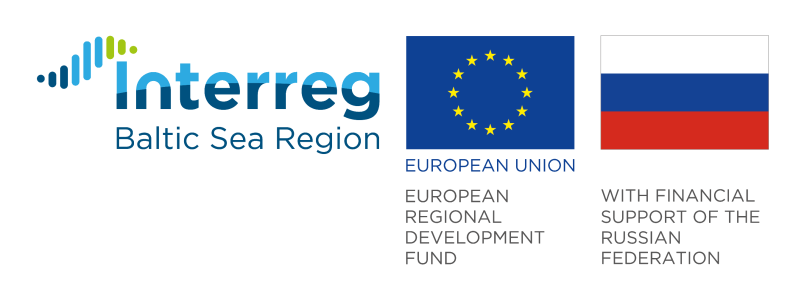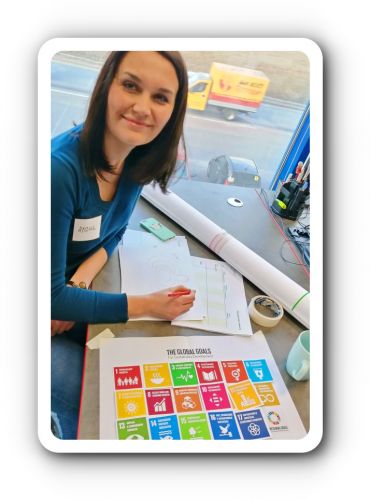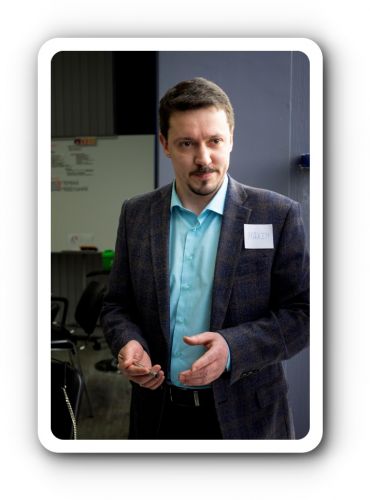pictures: MedinaArt St. Petersburg (Elena Gontarenko & Marina Lebedeva)
If you take the St. Petersburg metro line 5 to its penultimate station "Staraya Derevnya" ("Old Village") you will find yourself in an area populated by companies with their trading, exhibition and sales premises. The feel is far from village-y. One industry clearly dominates: furniture! Even the roads are named after it: Furniture Street, Furniture Passage...
Mental sport for circular furniture
The "First Furniture Factory" also has its workshops, showrooms and its own learning centre here. At the end of February 2020, one of its seminar rooms was filled with a mixed audience ready to take part in an "EcoDesign Sprint". No, this is not a new athletics discipline. Closer to a form of mental sport, played in small teams. In athletics, to sprint is to cover a set distance in the shortest possible time. Here, “Sprint” refers to generating solutions (sometimes even utopian ones) in a limited amount of time. It refers to joint, almost playful reflection in small, interdisciplinary groups. And "EcoDesign" stands for a systemic view of the "life of products" , considering the underlying design approaches that bring to life the principles of circular economy. In short, the "EcoDesign Sprint" is a training programme for companies and designers who, in a process of co-creation, develop company-specific solutions and offers for a circular economy. Results range from changed in-house approaches, to the redesign of existing products to the creation of new, circular business models. The Sprint format was developed by Design Forum Finland and the Finnish consultancy Ethica as part of the EU Interreg project in the Baltic Sea region "EcoDesign Circle". What’s new this year is the Sprint’s pilot implementation in neighbouring Russia, in a significantly tightened form.
Maps of ideas
This February morning, learning centre of the "First Furniture Factory" is filled with operational managers, technologists, marketing experts and designers from the Russian furniture manufacturer. There are also other experts from Russia and Finland as well as observers from Estonia and Germany. The sprint is facilitated by Anne Raudaskoski from Ethica, a Finnish consultant for circular economy. The room lights up with enthusiasm and sparks of inspiration – ideas that are visually captured and presented by the St Petersburg graphic artists from Scriberry. Maps of ideas are created. The mix of participants helps include as many perspectives as possible in the process of finding solutions. The furniture company’s goal is to create a prototype of a circular flow furniture item or even a new business model based on circular economy within the next few months.
World without wastes
First off, the theory part of the sprint starts with an introduction to the basic principles of "Circular Design" and examples from other companies. "Please believe, at least for the next two days, that it is possible to run completely without waste," requests Anne Raudaskoski. As soon as the first small group work has started, the room really comes to life. What are the current megatrends in politics, business, society, technology and the environment? Which ones are relevant for the company? Is there a change in terms of "ownership"? What about the increasing digitalisation? Do we still need physical exhibition space? What about waste avoidance? …
These short discussion sessions are repeated several times a day, often the members of the groups change. In the next step, ideas are pursued starting from the life cycle of a furniture item: materials, production, logistics, business model, the usage phase and the time after use. Can materials be labelled for easier re-use? Could waste be processed for 3D printing? Is it possible to return packaging - to implement a reverse logistics? Could the packaging be composted in the garden - possibly even contain integrated flower seeds? How can furniture parts be made more uniform? Is a lifetime warranty possible?
At the end of the first day, the room is covered in brightly coloured sticky notes and canvases - and pretty low on oxygen!
Nomination of best concepts
During the second sprint day, the aim is to develop concrete concepts on which the furniture company can base its work, focusing on methods from user-integrated design. For this purpose, small teams first collect their three favourite “circular” ideas from the previous day or add new suggestions. So to start with, a total of 18 of these ideas are up for discussion. Then the selection voting begins and – almost like a game of musical chairs – the number of favourite concepts is whittled down until only six nominated concepts are left to vote for with sticky dots. Each one is captured on a canvas: the target group, the core idea of the approach and the advantages for the users and the company are presented together with a sketch. The visual sketch is an essential aid. Not only because it helps overcome the occasional Babylonian jumble of languages in this international Sprint. But also because it sharpens everyone’s perception of the idea and helps participants arrive at a similar "imaginary state".
The six nominated "candidate concepts" include: a modular furniture system; a code system that promises customers more service and access to information and simplifies and accelerates processes in the company; a psychologically well thought-out rental system of furniture for a "happy office" – with enough flexibility for changes such as relocations, expansions or short-term presence. There is also a choice of packaging that can function as a playbox, and an amazingly simple smart kitchen of a different kind, based on projections. A sixth idea is based on furniture parts made of previously hardly used biological materials, which are virtually on the doorstep. Although there are three winners after the scoring, many of these solutions are conceivable – perhaps even in combination. This really is a win-win-win situation. In the following steps, a "customer journey" was used to test and further develop the ideas for user-friendliness, to test their circularity and to forge an action plan for the next immediate steps.
"Our first circular product"
Sprints enable top performance in a short time. However, there’s no hiding it: they also drain your strength! Working at a constant maximum of creativity takes its toll. Tired, but satisfied with what has been achieved so far, the participants comment: "It was good to have the helicopter view” and "The canvases that were prepared were very supportive." Praise also comes from Anne the presenter: "This was the biggest, but also the most active sprint group so far". And Aino Vepsäläinen from Design Forum Finland states: "The graphic facilitators were a really good help in making the concept ideas understandable. The visualisations are also a good documentation of the circular design principles for customers and employees of the company". And a representative of the First Furniture Factory concludes: "This will be the first circular product of our company!"
This completes the “Russian series” of the sequence of all three formats developed by the "EcoDesign Circle" project: The EcoDesign Learning Factory, which took place in October 2019 in St. Petersburg, and used exemplary cases to demonstrate "circular thinking". The EcoDesign Audit, conducted a few days before the Sprint at the "First Furniture Factory" with the developers of this tool from Estonia. The EcoDesign Audit is like a stethoscope that scans the "eco-design state" in the company and flags up possibilities and potential. And finally, the series culminated in the 2-day EcoDesign Sprint as described here. All workshops and consultancies in St. Petersburg were arranged by the Russian project partner of “EcoDesign Circle 4.0” – Medina Art. Since 2007, Medina Art has promoted sustainable design ideas in Russia and introduced new management practices into the production processes of Russian companies.
We are curious to see how these ideas – currently in their infancy – will develop and deliver. We’ll report back in a few months’ time. In the meantime – despite and especially during the current crisis - we wish the company the best of success!
(Russian subtitles available)




